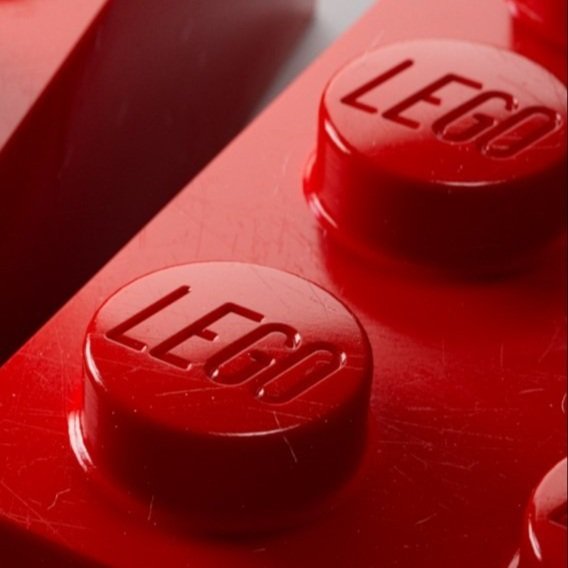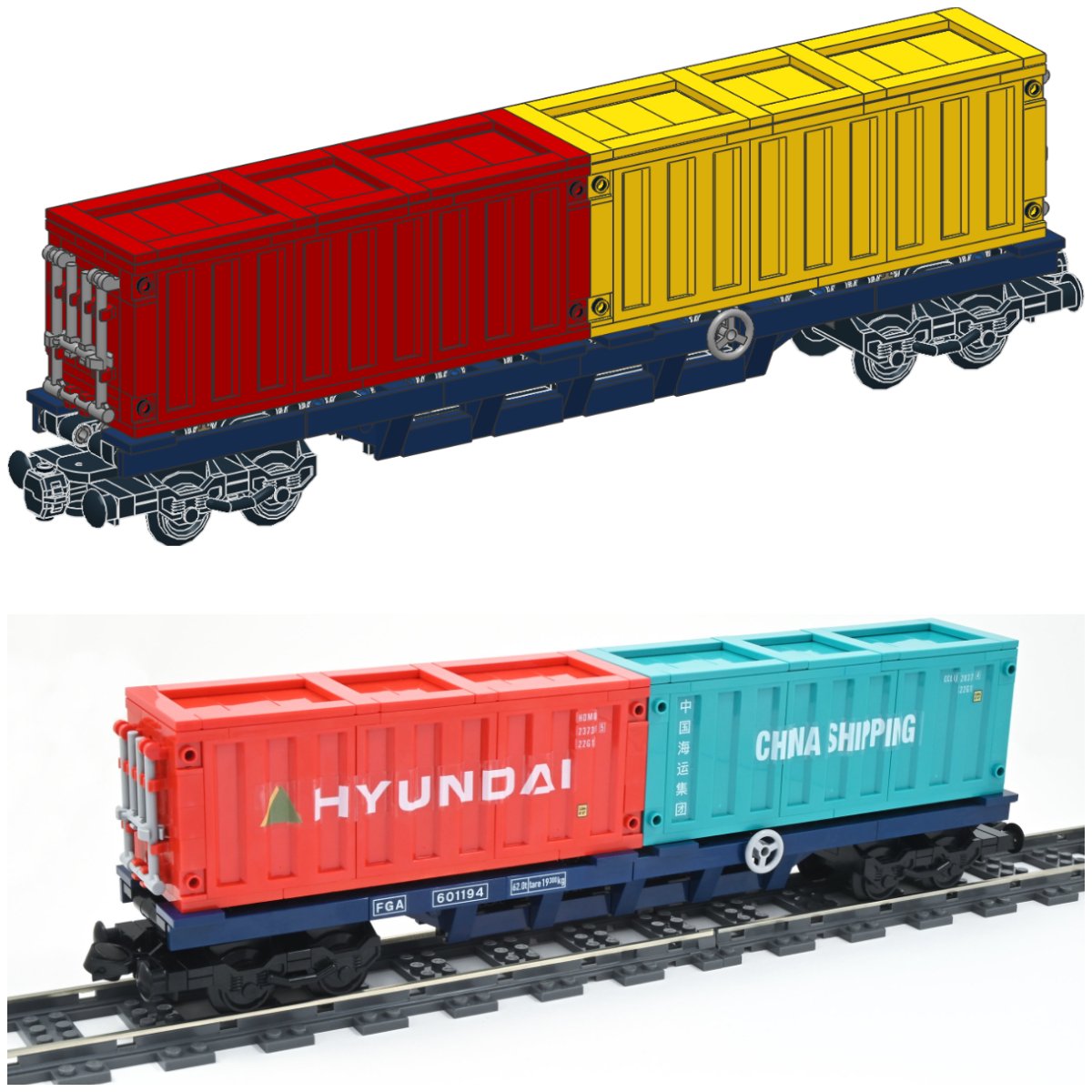One Color, Thirty-Nine Times: An Interview with Caz Mockett
/Best of BrickNerd: Weekend Highlight — Article originally published May 18, 2021.
Perhaps it’s because so many of us have been locked up in our own little cubes, but LEGO “Minifigure Habitats” have been in the zeitgeist a lot lately. My social media has been full of amazing, creative CMF (Collectible Minifigures) block-mocs this past year.
The first LEGO CMF series was released in 2010, and as early as that year, Eurobricks sponsored contests using them in “habitat” vignettes. To the best of our nerd-hivemind research, though, the modern, diagonal, stackable formula for “minifig habitats” came to be in 2016. Pangeran Panda shared his pattern that is based on the design used in the 2016 Olympic Bricks Festival in Jakarta, Indonesia, which garnered over one thousand entries in the category competition!
I can’t say whether I’ve seen thousands, but the icing on my habitat cake has been the wonderful series of MONOfigure habitats by Caz Mockett from the UK. Each of the THIRTY-NINE stackable habitats uses LEGO elements of only one color in the LEGO spectrum, with each individual cube involving a wholly unique character and style. Caz has been dropping these stacked gems three at a time on Instagram and Flickr, and now the spectrum is finally complete! Here is a photo of Caz and her MOCs to give you a sense of scale.
Caz was gracious enough to answer some of my burning questions about her series. Jump on board this tour of her brick-built habitats!
Gwyneth: Thanks for chatting with BrickNerd! When did you come up with the idea to create monochrome habitats? Was there a specific instance that caused the "spark"?
Caz: About two years ago, I saw a video of a huge collaborative Habitats display at an Australian LEGO convention. It had many different habitats, which provided great inspiration—including some for monofigures. At the time, I had no intention of collecting any myself, but I never really forgot about the habitats I had seen. When I finally succumbed to the monofigure bug, I had already been building habitats for many other minifigures, so it just seemed like the natural extension to do mono-colour builds for myself. I didn’t see it ending up with 39 and counting when I started!
Gwyneth: I think we’ve all had projects or collections snowball like that. Did you normally collect monofigures?
Caz: I had been resisting for some time, knowing how expensive some of them could be. But being a fan of all things colourful, eventually I cracked!
Gwyneth: Does this use your entire collection, or are there alternate figures that might show up in round two?
Caz: Round two!? Please, no! I have ideas for a small handful of new colours, but at present, the minifigures are not able to be completed yet, as the parts in the right colours don’t exist. I keep my hopes up though because LEGO is releasing new elements all the time—the torso/arms and new hairpiece in Vibrant Coral from the new VIDIYO sets are just some examples.
Gwyneth: Are all of these pieces original LEGO? (Or are any Brasso-ed?)
Caz: They are all genuine LEGO pieces, but it is impossible to build some monofigures without removing the prints. Brasso is definitely a great help to do this in the kindest way to the plastic. I’m a bit sick of the smell of the stuff though! I have usually removed prints where it was either impossible or prohibitively expensive to source an unprinted version.
Gwyneth: Did the individual characters come from the figures themselves, inspired by an accessory, or did they evolve as you built them?
Caz: Many monofigure collections you see online are just the basic figure: head (no hair), torso, arms, hands, and legs. But it was Instagram user lego_coffee who really spurred me into starting my own collection. He showed his series of monofigures who all had a hat or hair and some coordinating accessories, which I really liked. Then I started researching which parts were available for which colours (still not really thinking about building habitats at this point).
I began gathering a few parts from my own collection and gradually making BrickLink orders for other elements. I wanted to choose unusual pieces for each figure, which more or less ended up dictating their characters. Sometimes it was a hairpiece or hat, sometimes the accessory. I gave each one a name even before building the habitat.
The Medium Lavender figure is a case in point—I was surprised to find the classic LEGO City thief/villain’s woolly hat was available in such a lovely colour, so I knew immediately that the Medium Lavender guy was going to be a thief. Researching the colour revealed things like the big chest and shell pieces, which I felt fitted in nicely with a museum display, and the habitat naturally evolved from that starting point. The thief is depicted stealing some priceless exhibits during the night.
The Orange Dive Master was another: flippers, airtank, life vest and even a dinghy were all available in orange. Then it was just a question of how I was going to cram that boat into an 8x8 space. The solution: it sticks out through holes in the back wall! The fish and starfish that decorate the harbour walls were an extra added bonus—when I spotted them in the BrickLink catalogue it was fate.
Gwyneth: Are there any elements that came from a wildly different CMF that give you a secret giggle?
Caz: I haven’t really thought about that, to be honest. I suppose Bright Pink Batman in his tutu comes closest. I already had the cowl from one of my own minifigures, so it was a must that I chose him for that colour. The tutu really suggested some sort of starlet, and the delightfully kitsch dressing room habitat sprang from there.
Gwyneth: Do you normally sort by color? Did you develop a special sorting method for this project?
Caz: When I first came out of my Dark Age in 2017, my spare parts were sorted by colour. But I very soon realised that it was much easier to find a 1x1 red tile among other 1x1 tiles than a big bucket of red things—so now I sort by part first, and then colour if I have a lot of one piece in a particular colour. Usually for my MOCs, this is by far the most efficient way of sorting my collection to find something quickly. However, this project has been the one time when I have regretted not having things sorted by colour!
Gwyneth: Did you have most of the elements, or is there anything unique about how you sourced the pieces?
Caz: I built the first few habitats from pieces already in my collection once I had completed the minifigures. These were fairly common colours like Light Bluish Gray, Pearl Gold, Reddish Brown, Red, White and Dark Bluish Gray. I’m normally a “build-it-in-the-brick” MOC’er, but I soon realised that what I wanted to build for some colours would have to be done digitally first because I just didn’t have the parts.
Stud.io has a great feature where you can turn off all the elements that aren’t available in a particular colour, which has been invaluable for figuring out which pieces I was going to use, especially for the more obscure colours. It also lets you upload your model as a wishlist directly to BrickLink.
So I would design the habitat, upload a wishlist, go through my own collection to see what I already had from my “shopping list”—which is where having things sorted by part wasn’t such a bad move anymore—and then try to source the remaining parts from as few UK sellers as I could manage. I also kept a spreadsheet of progress for each figure and habitat (I love a good spreadsheet!), and at one point I think I was juggling about ten different wishlists simultaneously. While I was trying to get the parts for one thing, I would often find some of the other things I needed at the same store, so it did save me quite a bit on postage that way.
Gwyneth: We love spreadsheets here! Were any of the pieces expensive? How did you tack all the orders?
Caz: I researched each piece to find the lowest UK price, where available, and wrote that and the store name in the notes field of the item in the wishlist. Then when I spotted it in a different store (you can choose to display just the parts a store has from your wishlists if you want to), I had a good idea if they were charging a lot more than the lowest price.
Once an order had been placed, I moved all of the pieces into a wishlist called Ordered and wrote “ORDERED” in the notes field, along with the store name. It may sound like a lot of effort, but it stopped me buying things multiple times over, especially when pieces were in the post and had not yet arrived. It also meant I could switch off the Ordered wishlist when viewing what each store had, which made life easier for just seeing what else they had which I was still missing. I would say I probably had to order about 80% of the elements especially for the project, but it was spread over seven months—so the cost didn’t seem quite as terrible. Before you ask, no I haven’t added it all up!
Gwyneth: Did you wait to build each habitat until you had all the pieces?
Caz: For the first few habitats, I waited for all the parts to arrive before building them, but later on I got impatient to see their progress. So I would often build the whole thing with random colours as long as the shapes were correct, gradually replacing them one by one as each BrickLink order arrived. Here’s a selection of WIP shots:
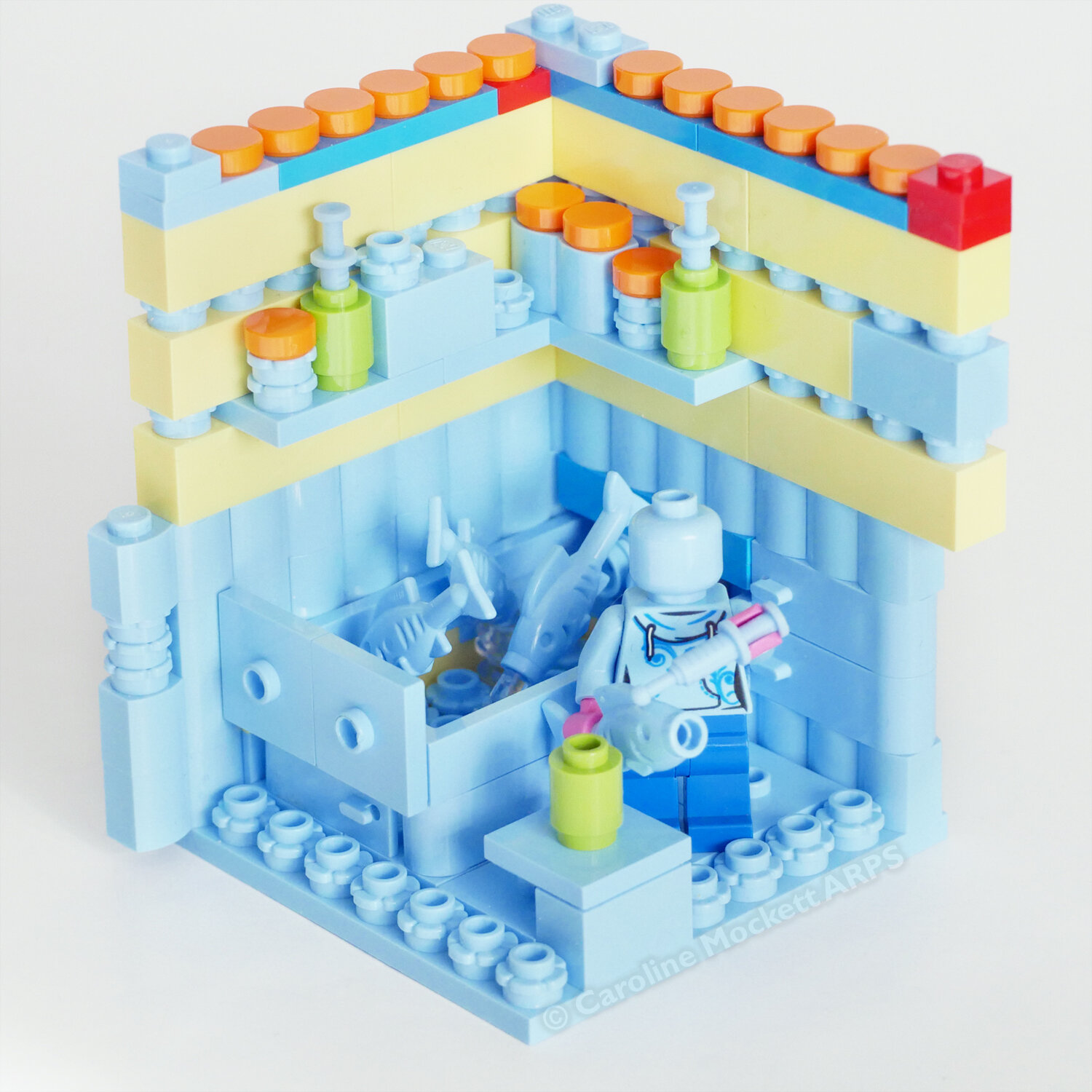
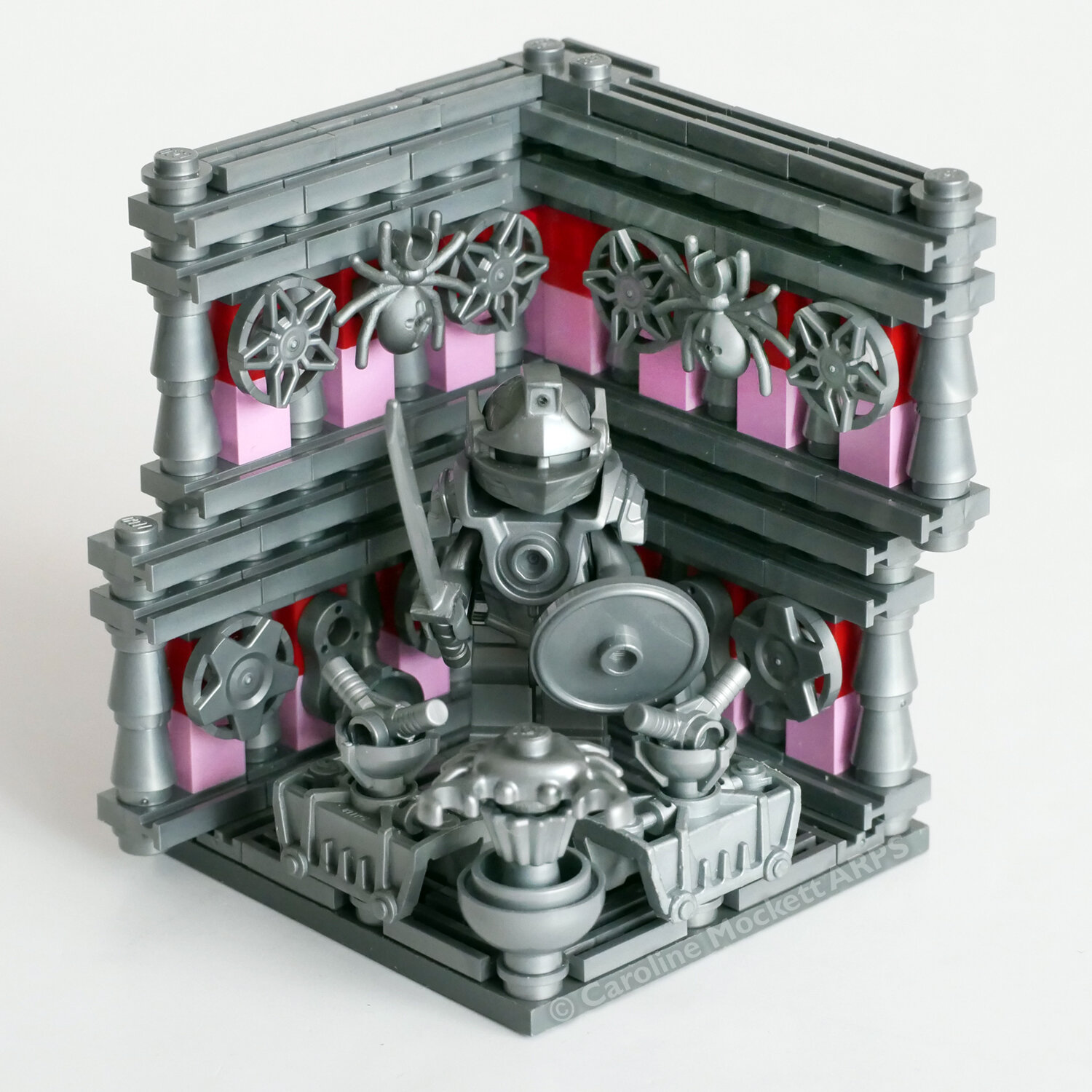
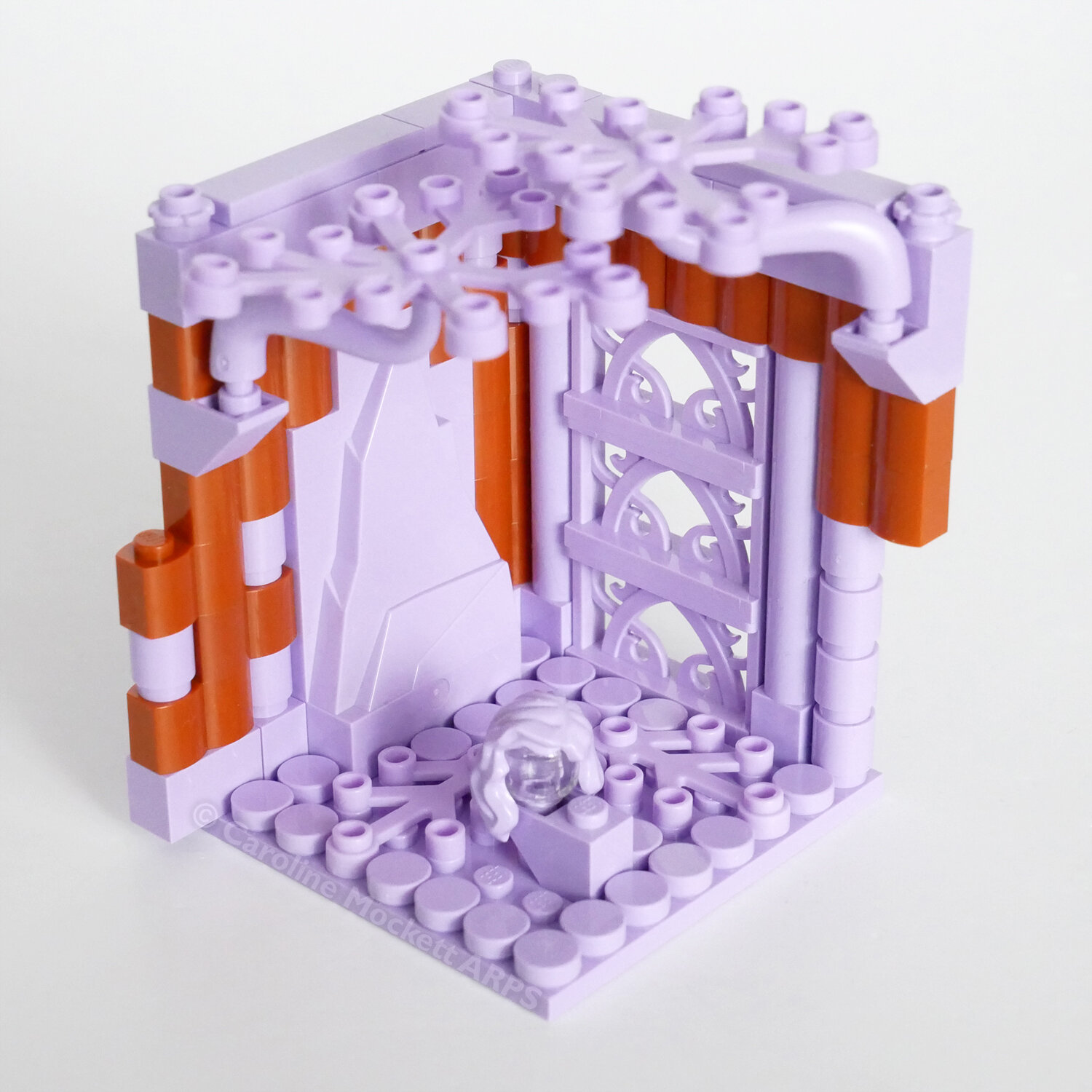
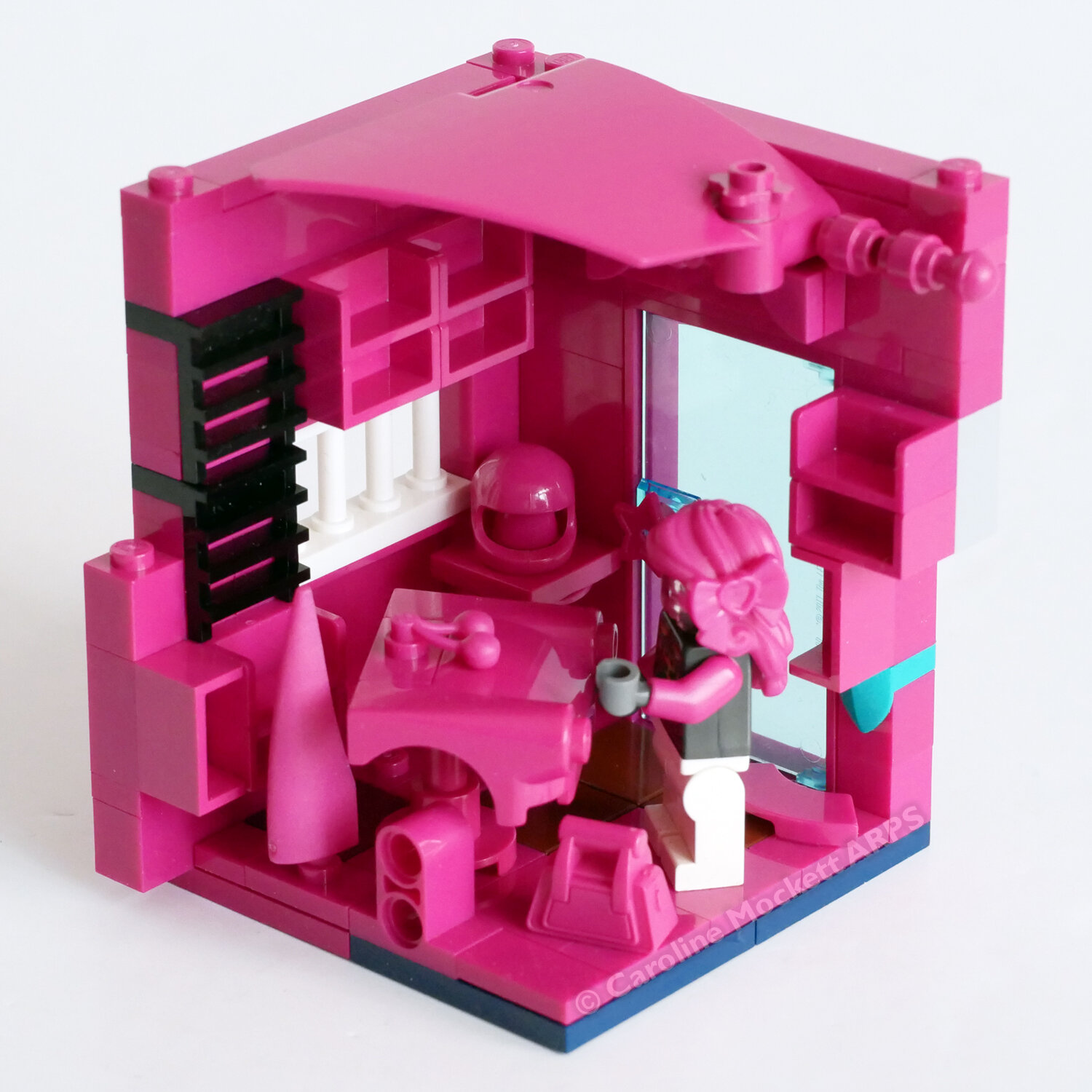
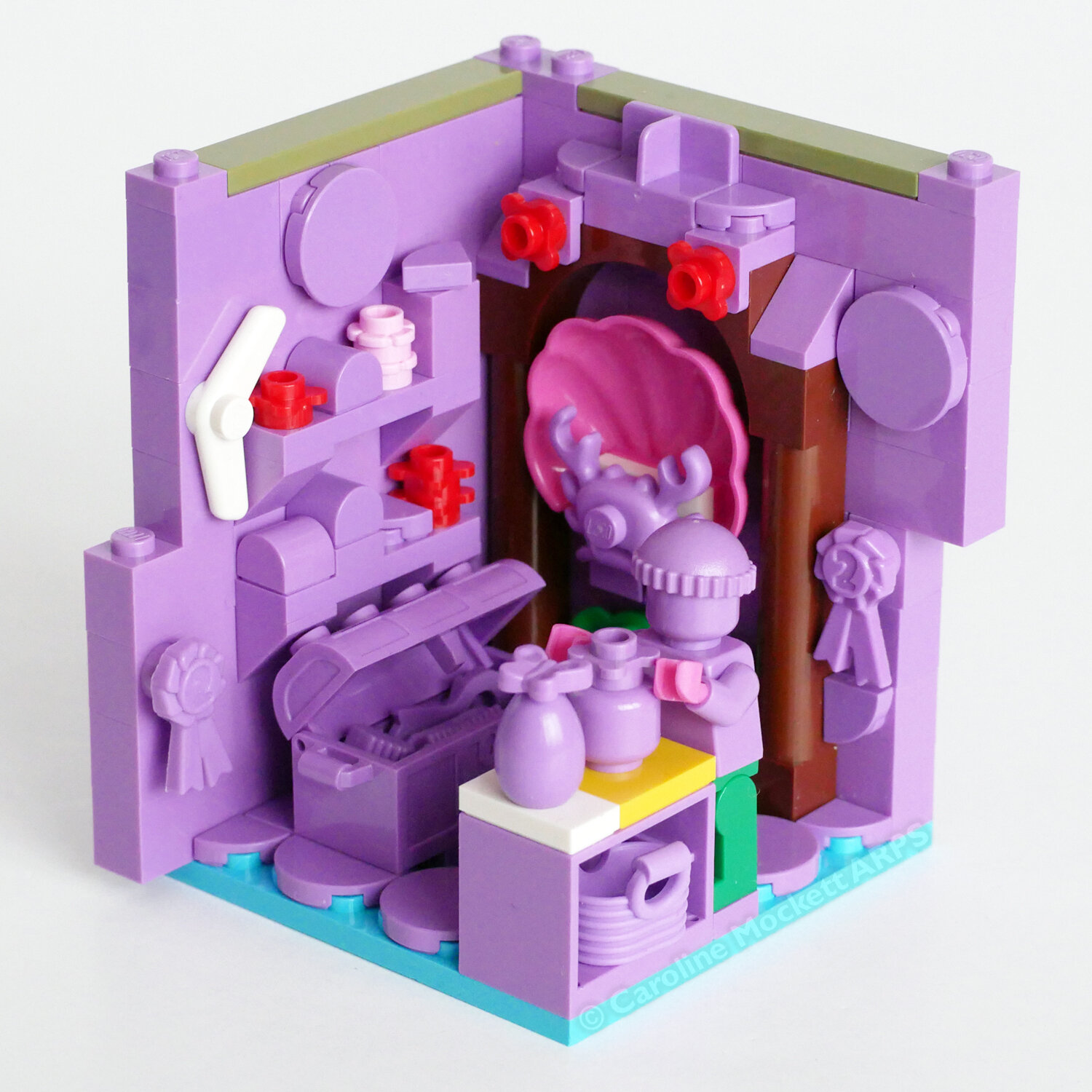
Gwyneth: Those are wonderful photos that offer great insight into the process. Did you research the individual colors? Did you learn anything surprising about LEGO and colors?
Caz: I love browsing via the Colour Guide on BrickLink, and yes, discovering some wonderful part in a strange colour which I had no idea existed was definitely a fun part of the whole process. As I said before, working in Stud.io also meant I could easily browse the parts in a single colour right from the part-picker palette. Although just because it exists, doesn’t mean it’s easy (or cheap!) to buy—so I did end up with one or two substitutions along the way. I was surprised by some of the weird things available in some colours, especially from LEGO’s back catalogue where parts are no longer in production, or a colour has fallen out of favour.
Gwyneth: I really love the variety of texture in the walls. Each box is so unique. Did the diverse stories tend to come from the figure, or were they sometimes inspired by the environment?
Caz: I think most of them came from the figure’s character first, which was usually dictated by the accessories I could find in that colour. I did want to avoid just having a boring flat wall for each, so I tried to add as much texture and variety as I could—sometimes gratuitously so! It proved difficult with some of the rarer colours though, due to the limited selection of parts.
It’s not that easy to add texture to a wall when there are no SNOT bricks or brackets available in that colour. Olive Green is a prime example where there are no bricks available with studs on the sides. But I was saved by being able to use the masonry bricks and the corrugated panels in that habitat, which made things more interesting—and fit in very well with the urban environment I was trying to portray.
Gwyneth: Were there any stories you had to give up on because a necessary element was not available in that color?
Caz: As the stories were led by the colours, and not the other way around, I think this wasn’t really an issue. I did have to make one order from Denmark for a handful of 1x1 Bright Green bricks with a stud on the side, in order to finish off the Brick Botanist’s habitat. And my lovely AFOL friend Jonas helped me source some of the wonderful “Fence 1 x 4 x 2 Ornamental with 4 Studs (19121)” in Teal from Belgium as there were none available at the time in the UK, but they seemed plentiful and cheap in Europe.
Gwyneth: Do you have a favorite color or habitat?
Caz: It’s really hard to choose just one! So I shall mention a few. The Yellow Pharaoh was an early build and a favourite because that wonderful headpiece dictated the rest of the build, and I knew he had to be seen inside his pyramid. Pearl Gold was satisfying because I was still able to make an interesting habitat despite a dire lack of useful bricks; my bacon was saved by those lovely fancy fence pieces.
Flat silver presented a similar issue. The only brick available in that colour is an extremely rare 1x1x2 brick with a square hole (The Piece of Resistance, part 15444), where just one example came in 70816 Benny’s Spaceship, Spaceship, SPACESHIP! I needed 16 of them, and only one BrickLink store in the UK had them—but they were very costly. They were not so hard to find in eastern Europe, and much cheaper, but the New Year parcels had been quite delayed coming from Europe due to COVID and Brexit. BrickLink’s estimated shipping charges virtually wiped out any savings I would have made, and there often seems to be random customs duty applied to orders coming into the UK.
So I agonised for several months about whether to buy them domestically or not. In the end, I caved. But that habitat was probably the longest in production (designed in December 2020 but not finished until April 2021). I think it also ended up being the most expensive habitat to build in total. And I managed to include a couple of Bionicle elements in that one, which surprised a few of my friends!
I also love the Dark Tan Desert Soldier—mostly for his camel, which was eye-wateringly expensive (the most expensive single piece in the whole project). Some folks have commented that I haven’t removed the eye print from the camel—given how expensive he was, I didn’t have the heart to ruin his value just for the sake of it—and viewed from a distance, you don’t really notice the print very much.
Gwyneth: I see you’ve done a little digital editing for the photo, but I think that’s acceptable for such an expensive part! But because these habitats are such works of monochromatic art, the Art History nerd in me sees in this the principle in which an artist deliberately includes an imperfection to emphasize their own humanity. Thank you, Caz for bringing our attention to all these wonderful details and for sharing your process with us!
You can see more of Caz Mockett’s work on her Instagram, Flickr and YouTube channel. We’ve also included a video on her monofigure habitats below. Enjoy!
Have you built minifigure habitats? What are some of your favorites you’ve seen? Do you know any Nerdy details about minifigure habitat history? Comment below!
Do you want to help BrickNerd continue publishing articles like this one? Become a patron to show your support, get early access, exclusive swag and more.




















